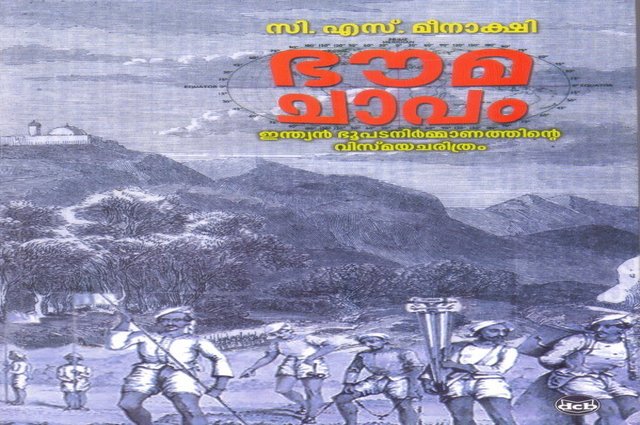28/10/2016
It’s not the first book to write the history of cartography in India or to chronicle the birth of those stupendous maps which mark the significant milestones in the cultural and political journey of a subcontinent through its protean visual traditions. But C.S. Meenakshi’s book Bhaumachaapam is probably the first to put together a passionate history of the extraordinary adventure called surveying, unravelling its epic dimensions and human drama. It has already made a buzz within the academia and among the amateur historians. It has also triggered a conversation among the Malayalee lay readership. Perhaps, rightly so. Because, a definitive myth of our dominant culture revolves around a surveyor called Vamana who measured the earth with three steps only to suppress a utopian reign forever.
Bhaumachaapam is all about the lineage of conquests through the white surveyors and their crucial role in furthering the play of colonial desire in this land. It’s a history of this country, particularly the Deccan region, perceived through a Herculean enterprise called the Great Trigonometrical Survey spearheaded first by William Lambton and later by a rare human being called George Everest. Yes, the very same indomitable spirit after whom the formidable Mount Everest is named. It’s an intriguing chronicle of an attempt to survey the natural and other resources of this highly challenging topography with its temperamental weather, its thick forest cover, intractable rivers, hilly landscapes and treacherous desert sands. An engineer by vocation, Meenakshi proves herself to be a compelling storyteller who can transform the apparently drabbest bits of information and statistics into the most vivid expressions of human emotion and existence. In this task of building an account of the fortunes of cartography in India, Meenakshi takes on the arduous responsibility of harnessing disparate documents from scattered resources and disciplines and organize them into an intelligible, informative and engaging narrative.
C.S. Meenakshi
After reading through the book with a rising sense of wonder at the sheer dedication, labor and sacrifice that went into the making of maps and the dense information nestling within all those impossible lines and drawings, I wish the book is made a compulsory read for all the geography and history teachers in our schools. No, not only to give them new insights, but to drive in the art of communication and the magic of storytelling. Because the book has made me change the way I look at those maps which were nightmares to me as a student. And Meenakshi’s evocative prose has made it a pleasurable read even for a non-expert like me. She makes it accessible and fascinating by bringing in the soft human touch, with a deft interweaving of poetry, myths and interesting anecdotes culled from the diaries, letters and personal documents of the surveyors. Such cultural allusions and resonances take away the tedium of ploughing through a whole lot of mathematical calculations, technical terminology and statistics, which must be of central importance to the expert, the specialist and the scholar in the field.
What has made the book appealing to even non-specialists is the huge human effort that Meenakshi compassionately maps out behind the seemingly bland and dull work called Survey. She yokes it to the narrative of colonial ambition and expansionist motives of the British empire, making it a powerful ally of British military plans. A strong critique of the exploitative tendencies that produced such a charged fervor to survey and document is balanced by a voice that gives due consideration to such initiative in impossible weather conditions braving contagious diseases, animal attacks, native resistance, mutinies and hostile topography. The author’s imaginative recreations of certain particularly hazardous forays made by these men into the dense jungles plagued by wild fever and their attempts to cross a Krishna river in full spate during heavy monsoons on elephant backs unspool the visual splendor of a story yet to be explored in print or on screen. She makes us familiar with an untold story and with unsung heroes like Major Branhill, Colonel Walker, Lieutenant Campbell, Thomas Hill and many others who even measured Shravanabelgola. And then there is the enigmatic story of Lieutenant Lambton who ended up in the jail of Travancore Maharajah for attempting to survey. Meenakshi draws upon the power of the anecdote to complicate our received understanding of history and its conventional telling.
The book is richly stacked with maps of different periods drawn with different purposes. The British held sway through their soldiers, traders, administrators and surveyors. Surveys were integral tools of imperial surveillance and war strategies were drawn up based on the information provided by these surveys. But they also involved long durations of sleepless nights watching the tracks of stars and defending themselves against possible robberies by the native communities like the Pindaris. Interesting inventories of items robbed are given in boxes along with the main narrative. Meenakshi gives special focus to the British encounter with Tipu Sultan, which became an immediate provocation for the British powers to wake up to the need of securing exhaustive information about the natural wealth and the lay of the land in the Southern parts of India. She dwells at length on the social impact of this collaborative project at the ground level of ordinary human relationships and attitudes between the colonizer and the colonized in the form of phobias and superstitious caution.
Even as the author and the publisher deserve appreciation for taking on this daunting project, one has to regretfully note that the production of a book of such promise and potential leaves a lot to be desired. Brought out by DC books, it leaves one wishing that it could have been more imaginatively executed from the cover design, and the font down to the display of Maps. The details in the maps are practically invisible and colorless. I wonder how a fellow scholar, let alone a lay reader, is going to benefit from such a clutter. I also found it a little difficult to find a pattern in the way the bibliographical details are recorded. It has the potential to be a coffee table book, but the pricing may not be easy on the pocket. Despite these shortfalls, the book reaches out to you with its sincerity, narrative power, historical sensitivity, spirit of involvement and delightful sense of humor. Malayalam language and culture is deeply enriched by this work of painstaking research, exciting scholarship and sharp perspective.
(Photo credit: The British Library via Foter.com)


